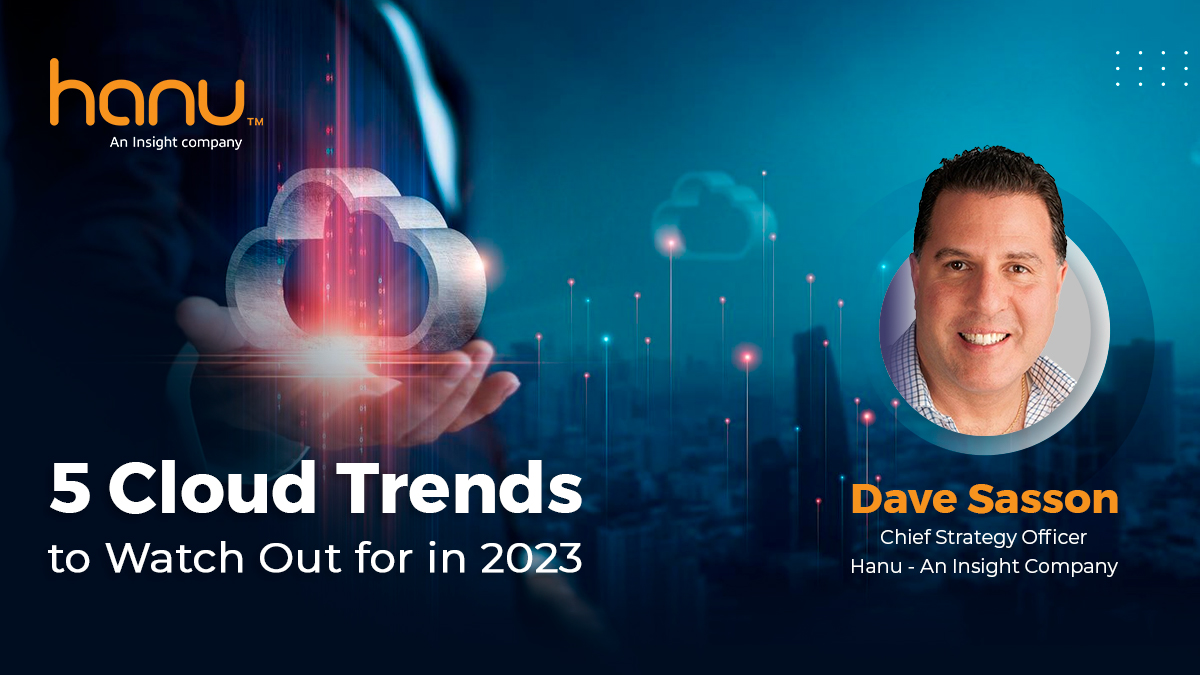
By Dave Sasson
With the pandemic drawing to a close, companies are beginning to increase their IT and cloud innovation investments. According to Gartner, worldwide spending is expected to grow 20.7% – up to $591.8 billion – in 2023 sources.
However, the increase in cloud adoption comes during a time of economic uncertainty. This will lead organizations to turn to agile, elastic, and innovative solutions to continue to grow and compete globally.
With that in mind, here are 5 trends to watch out for – and capitalize on – in 2023.
1. Artificial intelligence and machine learning come alive in the cloud
As cloud adoption grows and becomes more affordable, Artificial Intelligence (AI) and Machine Learning (ML) cloud services are becoming more attractive. This is in part due to companies realizing that they can leverage hyperscale cloud provider’s massive AI infrastructure without having to invest in building their own. Cloud providers know this, so expect to see a massive growth in AI services from Microsoft and other CSPs.
One area to look out for is adaptive AI. Adaptive AI systems learn within runtime and development environments and retrain quickly based on new data and changing circumstances. This allows AI applications to adapt rapidly on an ongoing basis, despite how they were programmed during their initial development. They are idea for operations in which there are many unknown variables, or simply when rapid change is the norm.
2. Cybersecurity is more important than ever
With the advantages that come with a cloud migration come a variety of new cybersecurity threats. As cloud adoption – and the regulations around it – continue to grow, companies are prioritizing cybersecurity and related innovations.
They key here is innovations. As the economy continues to look uncertain, organizations will be looking for cost-efficient cyber security solutions – think AI, predictive technology, and automation, as well as an increase in security-as-a-service adoption.
However, AI comes with it’s own set of risks. Due to widespread adoption, many companies have not increased their security posture to keep up with their AI solutions. This is a problem: according to a recent Gartner survey, 41% of organizations reported a security breach or privacy incident related to AI.
Companies looking to incorporate AI need to be aware of what Gartner dubs TRiSM: trust, risk and security management systems and protocols. This will require a seasoned solution provider to lead multiple business units to implement new company-wide security measures.
3. Industry cloud platforms will rise in popularity
As cloud technology becomes a more integral part of every company, specific industry solutions are becoming more common – so much so thatby 2027 50% of organizations will use industry cloud platforms.
An industry cloud platform is exactly what it sounds like: a combination of SaaS, PaaS, and IaaS that provides modular capabilities to support specific industry use cases.
Industrycloud platforms provide innovation, agility, and reduced time to market, andcan act as a jumping off point for unique business initiatives. Their value lies in incorporating cloud services that are usually acquired separately and bundling them into a customizable, integrated package.
Microsoft Azure offers Industry Clouds for the following sectors:
- Automotive
- Banking
- Capital markets
- Consumer goods
- Defense and intelligence
- Education
- Energy
- Financial services
- Government
- Healthcare
- Insurance
- Manufacturing
- Media and entertainment
- Nonprofit
- Public safety and justice
- Retail
- Sustainability
- Telecommunications
4. Sustainability will grow as a key consideration for executives
After profit and revenue, sustainability and social changeis the third most important priority for investors. Therefore, leadership needs to invest in addressing ESG demand and meeting sustainability goals – and they need the help of technology to get there.
Expect to see more organizations adopt sustainable technology frameworks that improve traceability and renewable energy, increase energy efficiency for their IT services, and offer their customers more ways to meet their sustainability goals.
Sustainable technologies that have an environmental impact should also create new business value. With data-driven insights and better integration and visibility into supply chains, operational efficiencies will arise that will reduce costs and present new opportunities.
Microsoft Azure customers have access to Microsoft Cloud for Sustainability, which provides the following benefits:
- Unified data intelligence for increased visibility and improved sustainability reporting.
- Sustainable IT infrastructure systems that help identify opportunities to make systems, activities, and tools more efficient.
- The ability to track environmental footprint of operational systems to reduce your overall footprint.
- Build sustainable value chains through enhanced accountability and ability to source the most environmentally friendly material.
5. Organizations will leverage automation to drive innovation while decreasing costs
With the centralization of data and the increasing power and accessibility of AI, companies will begin to rely more on automation.
This will take several forms. An important one is in data-driven decision making. By creating a data fabric, companies will be able to offload specific, strategic decisions to AI algorithms. By using machine learning to integrate siloed data, previously unseenbusiness opportunities can be analyzed and acted on.
Additionally, Robotic Process Automation (RPA) is growing in adoption, with 72% of organizations expected to implement RPA over the next 2 years. Benefits include improved process efficiency, as well as a 79% reduction in errors, according to one IDC survey.
Want to explore how your organization can leverage the cloud and upcoming trends to enable growth and innovation in 2023?



